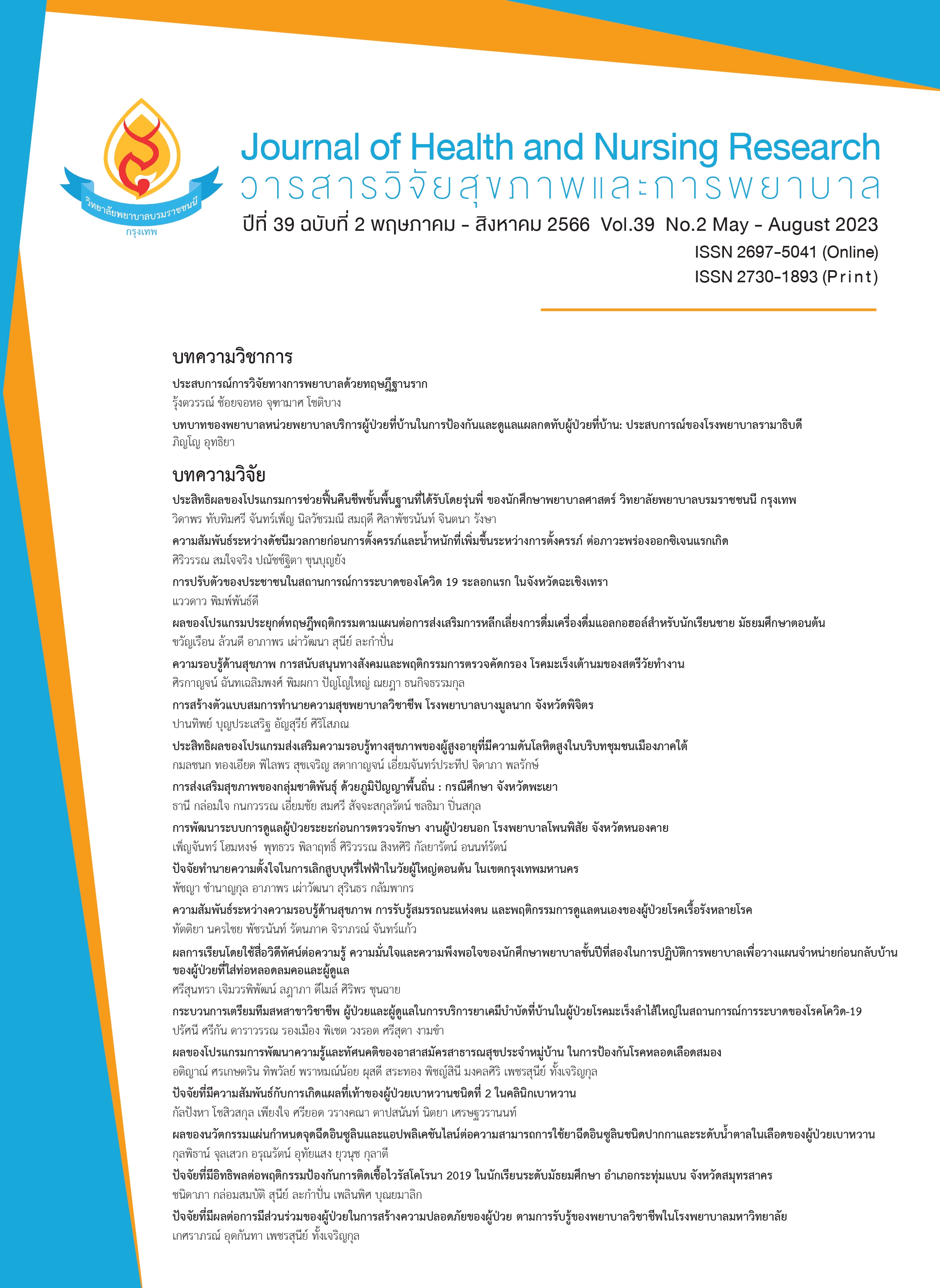ความสัมพันธ์ระหว่างดัชนีมวลกายก่อนการตั้งครรภ์และน้ำหนักที่เพิ่มขึ้นระหว่างการตั้งครรภ์ ต่อภาวะพร่องออกซิเจนแรกเกิด
คำสำคัญ:
ภาวะพร่องออกซิเจนแรกเกิด , ดัชนีมวลกายก่อนการตั้งครรภ์ , น้ำหนักที่เพิ่มขึ้นระหว่างการตั้งครรภ์, ระยะตั้งครรภ์บทคัดย่อ
บทนำ: จากสถิติพบอัตราการเกิดภาวะพร่องออกซิเจนแรกเกิดสูงกว่าเกณฑ์และเป็นสาเหตุทำให้เกิดการตายปริกำเนิด ทั้งนี้ยังพบมารดาที่เข้าสู่ระยะคลอดมีภาวะน้ำหนักเกินและภาวะอ้วนเพิ่มสูงขึ้น
วัตถุประสงค์การวิจัย: เพื่อศึกษาความสัมพันธ์ระหว่างดัชนีมวลกายก่อนการตั้งครรภ์ (BMI) และน้ำหนักที่เพิ่มขึ้นระหว่างการตั้งครรภ์ (GWG) ต่อภาวะพร่องออกซิเจนแรกเกิดในหญิงครรภ์เดี่ยวครบกำหนด
ระเบียบวิธีวิจัย: การวิจัยเชิงวิเคราะห์แบบย้อนหลังจากข้อมูลทุติยภูมิของหญิงครรภ์เดี่ยวครบกำหนด ที่มีอาการเจ็บครรภ์และคลอดที่หน่วยงานห้องคลอด โรงพยาบาลนครปฐมในเดือนมกราคม ถึง เดือนธันวาคม 2563 แบ่งเป็นเวชระเบียนของมารดาที่ทารกมีคะแนน APGAR > 7 จำนวน 215 ฉบับ และมีคะแนน APGAR < 7 จำนวน 85 ฉบับ เครื่องมือที่ใช้ในการวิจัยเป็นแบบบันทึกข้อมูล ประกอบด้วย ข้อมูลส่วนบุคคล ข้อมูล การตั้งครรภ์และการฝากครรภ์ BMI ก่อนการตั้งครรภ์และ GWG วิเคราะห์ข้อมูลโดยใช้สถิติเชิงพรรณนา สถิติสเปียร์แมนและวิเคราะห์ถดถอยโลจิสติคทวิ
ผลการวิจัย: BMI ก่อนการตั้งครรภ์มีความสัมพันธ์ทางลบกับคะแนน APGAR ระดับต่ำ (rs= -0.246) GWG กลุ่ม BMI เกินเกณฑ์มีความสัมพันธ์ทางลบกับคะแนน APGAR ระดับปานกลาง (rs= -0.489) ผลการวิเคราะห์ถดถอยโลจิสติคทวิพบว่ากลุ่ม BMI เกินเกณฑ์ ( = 7.63, p < 0.01) และ GWG >11.5 kg. (
= 9.6, p < 0.01) มีอิทธิพลต่อภาวะพร่องออกซิเจนแรกเกิด โดยสามารถร่วมกันทำนายภาวะพร่องออกซิเจนแรกเกิดได้ร้อยละ 23.6 (Cox and Snell R square = .236, Negalkerke R square = .318)
สรุปผล: หญิงตั้งครรภ์ที่มี BMI ก่อนการตั้งครรภ์เกินเกณฑ์และมี GWG > 11.5 kg. ส่งผลให้มีคะแนน APGAR น้อย โดยทำให้เกิดภาวะพร่องออกซิเจนแรกเกิด 7.6 เท่า และ 9.6 เท่า ตามลำดับ
ข้อเสนอแนะ: พยาบาลผดุงครรภ์และผู้ที่เกี่ยวข้องควรให้ความสำคัญกับการเตรียมความพร้อมก่อนตั้งครรภ์ให้มี BMI ที่เหมาะสมและควรกำหนด GWG ให้เหมาะสมสำหรับหญิงตั้งครรภ์แต่ละราย
Downloads
เอกสารอ้างอิง
World Health Organization. ICD-10 Version 2019 [Serial online] [Internet]. Geneva: World Health Organization; 2019 [cited 2020 Jun 12]. Available from: https://icd.who.int/browse10/2019/en#/P21
World Health Organization. Newborn Mortality [Internet]. 2022 [cited 2020 Jun 12]. Available from: https://www.who.int/news-room/fact-sheets/detail/levels-and-trends-in-child-mortality-report-2021
Workineh Y, Semachew A, Ayalew E, Animaw W, Tirfie M, Birhanu M. Prevalence of perinatal asphyxia in East and Central Africa: systematic review and meta-analysis. Heliyon. 2020;6(4):e03793.
United Nations Inter-agency Group for Child Mortality Estimation. Levels & Trends in Child Mortality: Report 2019 Estimates developed by the United Nations Inter-agency Group for Child Mortality Estimation [Internet]. New York: United Nations Children’s Fund; 2019. [cited October, 2019]. Available from: https://www.unicef.org/media/60561/file/UN-IGME-child-mortality-report-2019.pdf
National Institute of Child Health Development. The results of the development screening campaign for the year 2020. Paper presented at National Institute of Child Health Development Meeting; 2020 Aug 13; Thailand. (in Thai) [cited October, 2021]. Available from: https://nich.anamai.moph.go.th/web-upload/migrated/files/nich/n819_57c086f83458c45371180494cb01030c_DS_03.pdf
Department of Health, Ministry of Public Health. Birth Asphyxia Rate of Regional Health [Internet]. 2021. (in Thai) [cited October, 2021]. Available from: http://dashboard.anamai.moph.go.th/dashboard/birthasphyxia/index?year=2021
Nakhon Pathom Hospital. Nakhon Pathom Hospital Annual Report 2021; 2021. (in Thai)
Panna S. Risk Factors for Birth Asphyxia in Newborns Delivered at Nongkhai Hospital. Srinagarind Medical Journal. 2020;35:278-86. (in Thai)
Saksangawong S, Rattanamongkolgul S. Risk Factor and Risk Score for Birth Asphyxia in Kumpawapi Hospital, Udonthani Province. Royal Thai Army Medical Journal. 2019;72:41-52. (in Thai).
Booranavanich K, Cheawcharnprapan K. Risk Factors Affecting to Perinatal Asphyxia in Faculty of Medicine Vajira Hospital. Vajira Medical Journal. 2020;64(1):11-22. (in Thai).
NHS Digital. NHS Maternity Statistics 2018–2019. NHS Digital; 2019. Available from: https://files.digital.nhs.uk/D0/C26F84/hosp-epis-stat-mat-summary-report-2018-19.pdf.
Zhao R, Xu L, Wu ML, Huang SH, Cao XJ. Maternal pre-pregnancy body mass index, gestational weight gain influence birth weight. Women and Birth. 2018;31:e20-e25.
Johansson S, Sandström A, Cnattingius S. Maternal overweight and obesity increase the risk of fetal acidosis during labor. Journal of Perinatology. 2018;38: 1144–50.
Njagu R, Adkins L, Tucker A, Gatta L, Brown HL, Reiff E, et al. Maternal weight gain and neonatal outcomes in women with class III obesity. The Journal of Maternal-Fetal & Neonatal Medicine. 2020;35(3):1-5.
Choi H, Lim JY, Lim NK, Ryu HM, Kwak DW, Chung JH, et al. Impact of pre-pregnancy body mass index and gestational weight gain on the risk of maternal and infant pregnancy complications in Korean women. Int J Obes (Lond). 2022;46:59-67. doi: 10.1038/s41366-021-00946-8.
Memon MA, Ting H, Cheah J-H, Thurasamy R, Chuah F, Cham TH. Sample Size for Survey Research: Review and Recommendations. Journal of Applied Structural Equation Modeling. 2020;4(2):i–xx.
Bartz AE. Basics Statistical Concepts. 4 th ed. New Jersey: Prentice Hall; 1999. cited in Wijitwanna S. Correlation in Statistics: How to Use. Rajapruk University Journal. 2022;8(2):1-15.
Klemetti MM, Teramo K, Kautiainen H, Wasenius N, Eriksson JG, Laine MK. Late-Pregnancy Fetal Hypoxia Is Associated With Altered Glucose Metabolism and Adiposity in Young Adult Offspring of Women With Type 1 Diabetes. Frontiers in Endocrinology (Lausanne) 2021;12:738570. doi: 10.3389/fendo.2021.738570.
Çalik KY, Yildiz NK, Erkaya R. Effects of gestational weight gain and body mass index on obstetric outcome. Saudi Journal Biological Science. 2018;25(6):1085-9.
Álvarez D, Muñoz Y, Ortiz M, Maliqueo M, Chouinard-Watkins R, Valenzuela R. Impact of Maternal Obesity on the Metabolism and Bioavailability of Polyunsaturated Fatty Acids during Pregnancy and Breastfeeding. Nutrients. 2020;13(1):19.
Singh K, Goel A, Narain A. Gestational weight gain and its effect on fetomaternal outcome. International Journal of Reproduction, Contraception, Obstetrics and Gynecology. 2020;9(11):4477-81.
ดาวน์โหลด
เผยแพร่แล้ว
รูปแบบการอ้างอิง
ฉบับ
ประเภทบทความ
สัญญาอนุญาต
ลิขสิทธิ์ (c) 2023 วารสารวิจัยสุขภาพและการพยาบาล (วารสารวิทยาลัยพยาบาลบรมราชชนนี กรุงเทพ)

อนุญาตภายใต้เงื่อนไข Creative Commons Attribution-NonCommercial 4.0 International License.
บทความที่ได้รับการตีพิมพ์ เป็นลิขสิทธิ์ของวารสารวิจัยสุขภาพและการพยาบาล (วิทยาลัยพยาบาลบรมราชชนนี กรุงเทพ) ไม่สามารถนำไปตีพิมพ์ซ้ำในวารสารฉบับอื่น


















